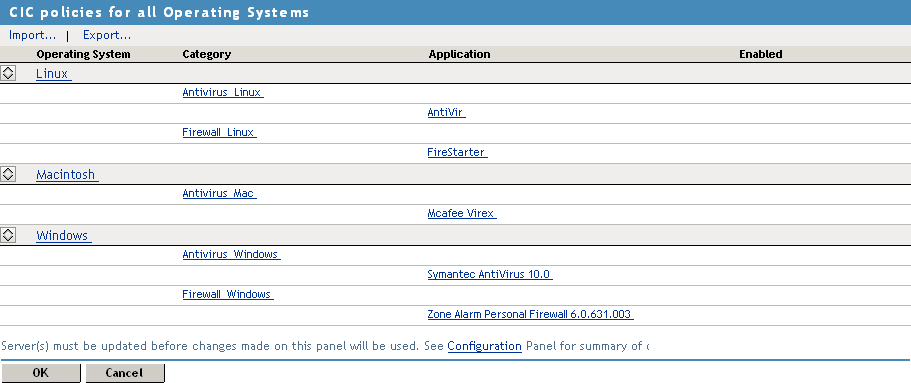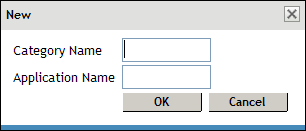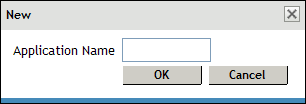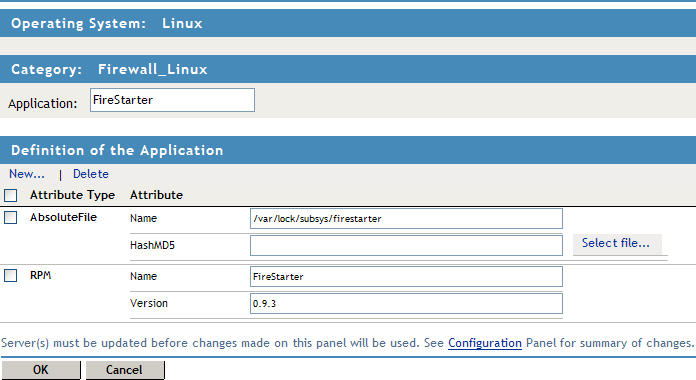4.1 Configuring Policies to Check the Integrity of the Client Machine
You can configure a client integrity check policy to verify if the prescribed software (such as firewall and antivirus software) is installed on the client machine. You can configure different policies for Windows, Linux, and Macintosh machines, then specify applications that must be present in the client machines in order to pass the client integrity check.
A category that you have configured can be deleted only if it is not assigned to any of the security levels.
4.1.1 Selecting the Operating System
-
In the Administration Console, click > .
-
Select from the section.

-
Select the operating system.
Next, you must configure a category of software that needs to be present in the client machine.
-
Continue with Configuring the Category.
For more information on exporting and importing client integrity check policies, see Section 4.1.5, Exporting and Importing Client Integrity Check Policies.
4.1.2 Configuring the Category
A category is a group of similar software. For example, a firewall category can contain a list of firewalls such as the Windows Firewall and ZoneAlarm firewall. You can configure multiple software categories for a single client integrity check policy.
When multiple categories are configured for an operating system, if one of the enabled category does not exist on the client, the client integrity check fails.
-
To add a new category, click .

-
Specify a name for category and a name for the application in the and the fields, then click .
-
Select the newly added category, then click .

-
To disable a category that is already enabled, select the category, then click .
-
To delete a category, select the category, then click .
-
Click to save your modifications, then click on the Configuration page.
-
Continue with Configuring Applications for a Category.
4.1.3 Configuring Applications for a Category
A category consists of group of applications. You can add more than one application under a category. A client workstation is checked for the presence of any one of the software items in the category. If at least one of the enabled application definition exists on the system, the client integrity check passes.
-
To configure or add applications to a category, click the category.

-
To add a new application, click .

-
Specify an application name, then click .
-
Select the newly added application, then click .
NOTE:To enable an application you must have already enabled the category that the application is part of.
-
To disable an application that is already enabled, select the application, then click .
-
To delete an application, select the application, then click .
-
Click to save your modifications, then click on the Configuration page.
-
Continue with Configuring Attributes for an Application.
4.1.4 Configuring Attributes for an Application
After you have added an application to a category, you must configure the attributes for each of these applications. These attributes can be in the form of RPMs, processes, registry keys, or executable files. The client integrity check detects the presence of these attributes.
-
To add a new attribute, click , specify an attribute name, then click .
-
Click the application to add application details and attributes.

-
Specify details for the attributes. The following table lists the attributes for applications on different operating systems:
-
To delete an attribute, select the attribute, then click .
-
Click to save your modifications, then click on the Configuration page.
-
To continue with configuring a connection and traffic policy for a client, proceed with Section 4.2, Configuring Client Security Levels.
4.1.5 Exporting and Importing Client Integrity Check Policies
You can export the client integrity check policy configuration into an XML file and import it back into the server.
You can modify the exported file without violating the schema format to include anew configuration. The new configuration is included when the file is imported.
Exporting Client Integrity Check Policies
-
In the Administration Console, click > .
-
Click in the Policies section. The Client Integrity Check Policies page is displayed.
-
Select the policies that you want to export, then click . This exports the configuration for all the platforms, categories, and applications.
-
Specify a filename for the XML document that saves the configuration.
-
Specify a location to save the XML file.
-
Click to save.
Importing Client Integrity Check Policies
-
In the Administration Console, click .
-
Do one of the following:
-
If you want to import the client integrity check policy configuration to an individual server, select the server, then click .
-
If you want to import the client integrity check policy configuration of a cluster, select the cluster, then click .
-
-
Click in the Policies section.
-
Click .
-
Browse and select the XML file that contains the saved client integrity check policies configuration.
-
Click .
-
To save your modifications, click , then click on the Configuration page.